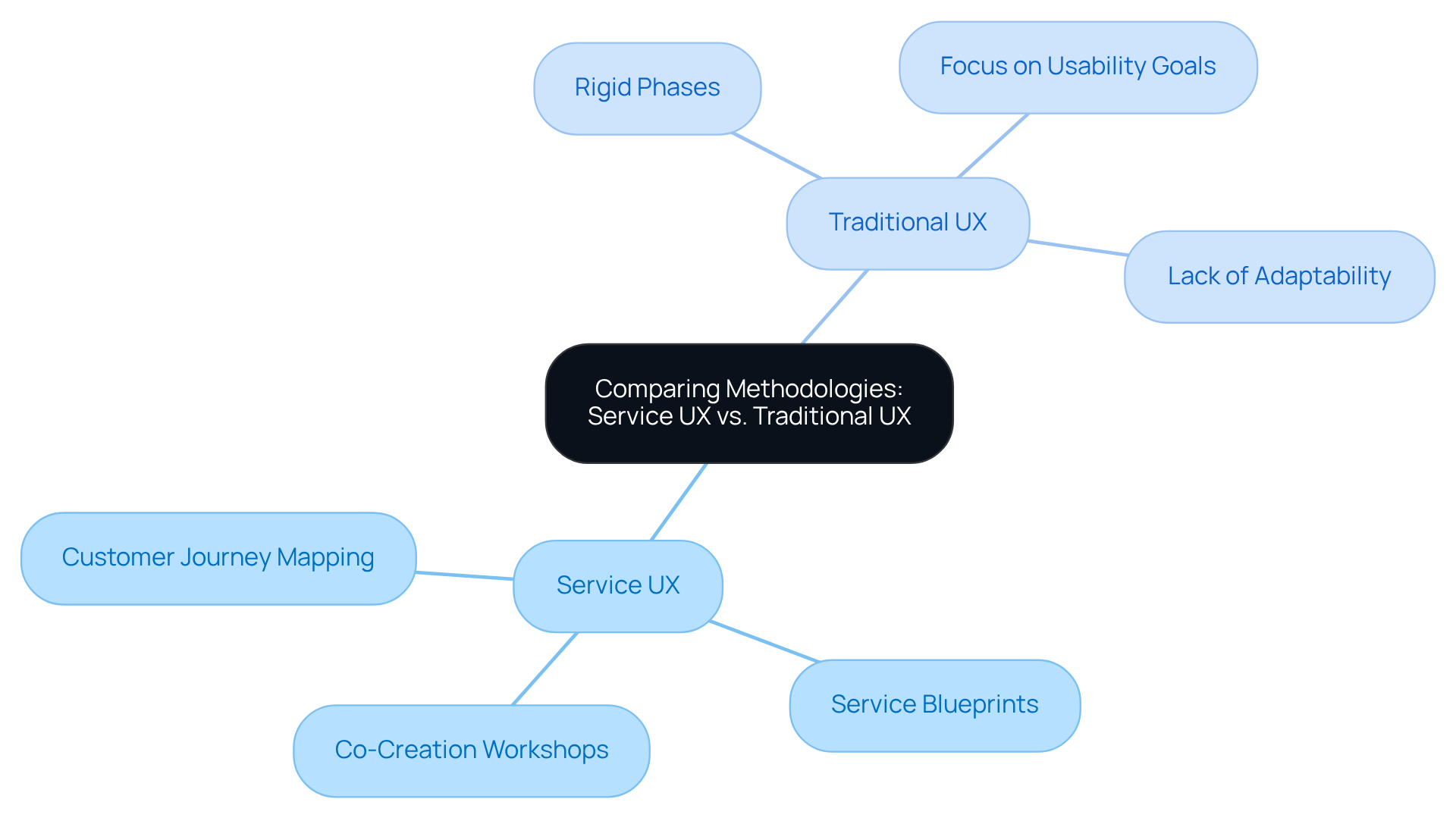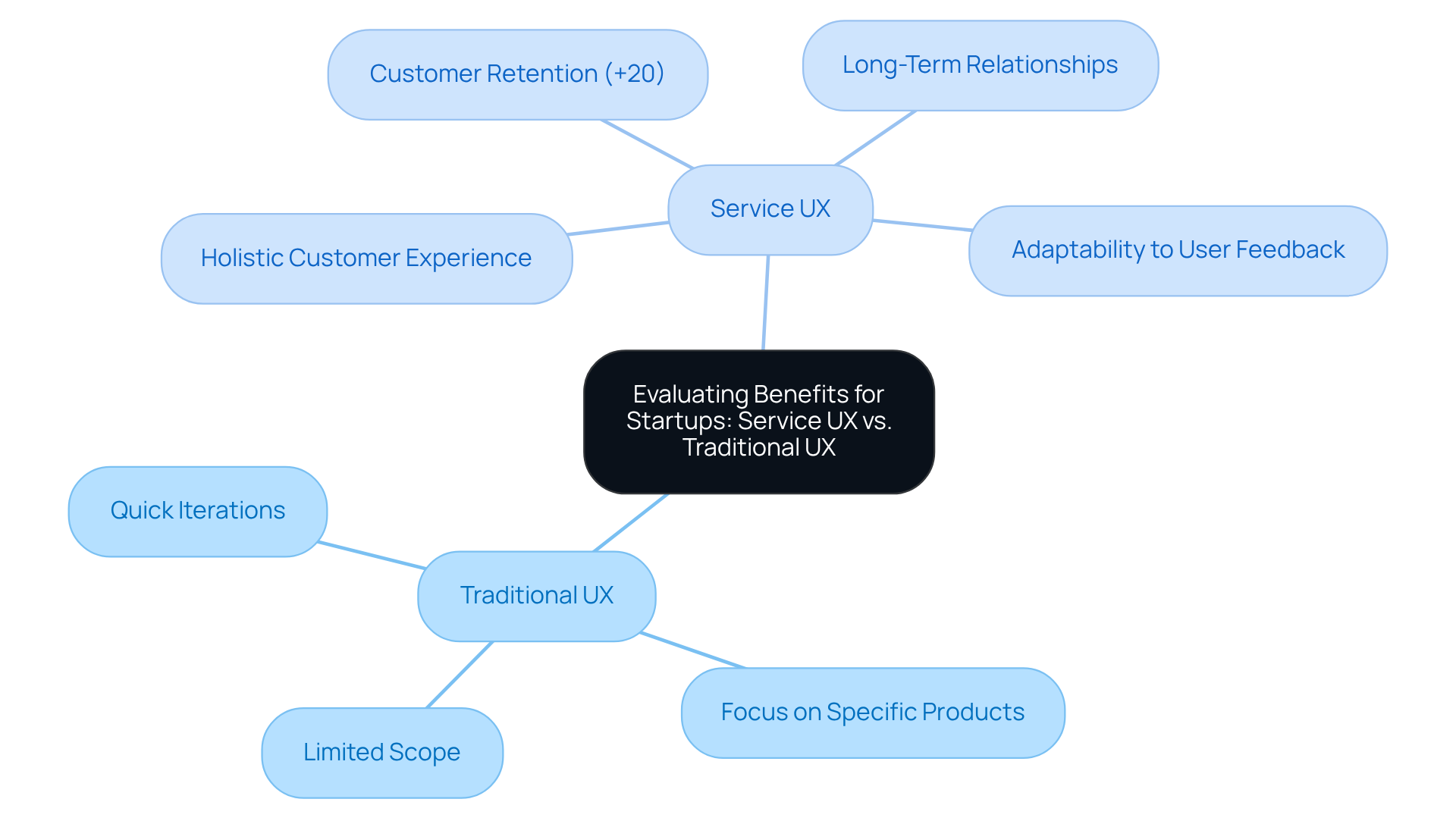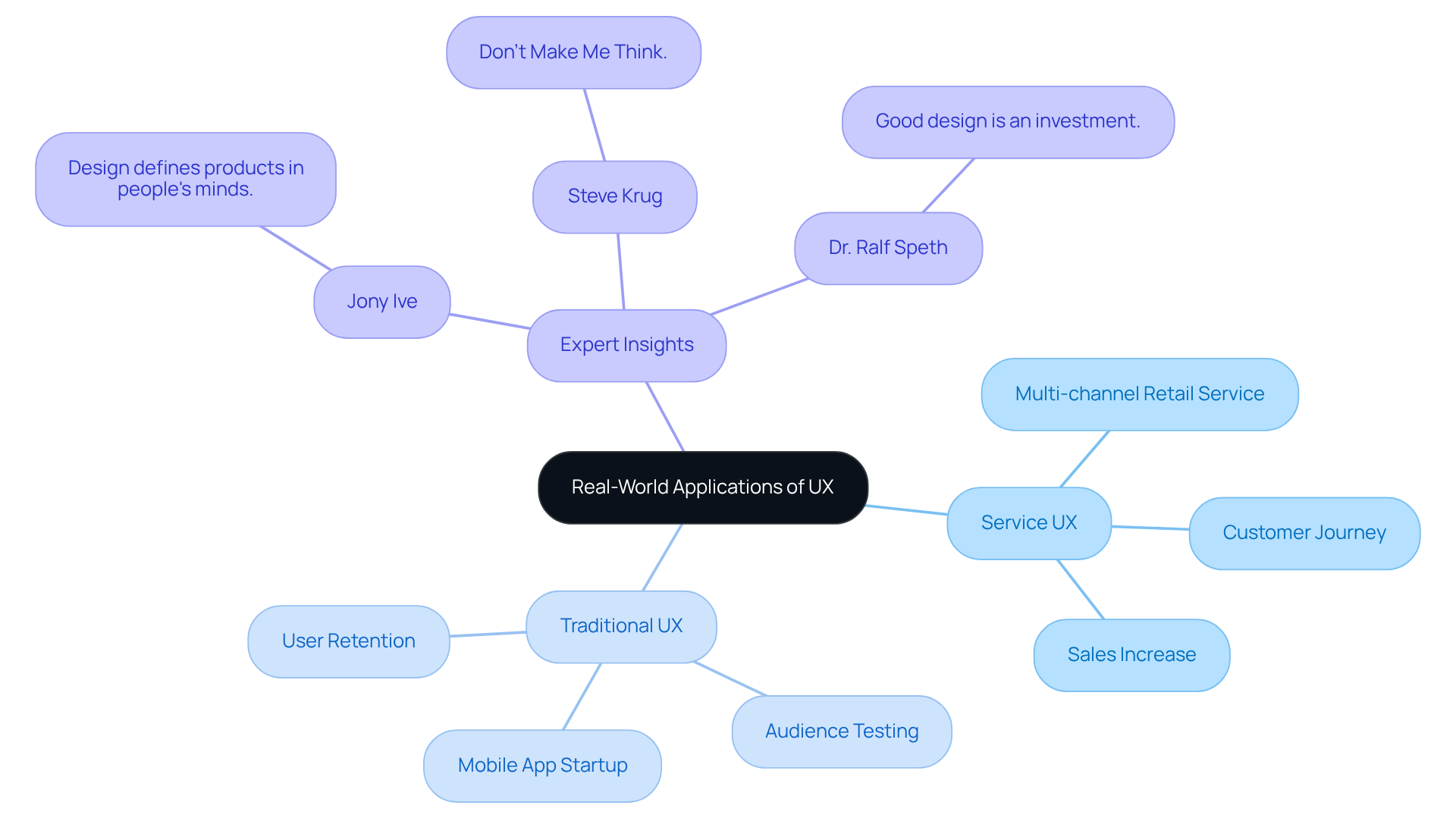Overview
In today's fast-paced digital landscape, many tech startup founders grapple with the challenge of understanding the nuances between Service UX and Traditional UX. This distinction is crucial, as it can significantly impact customer relationships. While Traditional UX focuses on specific digital interactions, Service UX encompasses the entire service journey, creating a more holistic experience for users.
Imagine pouring your heart into developing a product, only to realize that isolated interactions aren't enough to foster lasting connections with your customers. This can lead to frustration and diminished customer retention. Startups that embrace a Service UX approach, however, can cultivate deeper relationships with their users, resulting in higher satisfaction and loyalty.
By recognizing the importance of a comprehensive service journey, you can create meaningful experiences that resonate with your audience. This nurturing approach not only enhances customer satisfaction but also builds a supportive community around your brand. Together, let’s explore how adopting a Service UX mindset can transform your startup and lead to lasting success.
Introduction
In a world where user experience can make or break a startup, it’s vital to recognize the subtleties between Service UX and Traditional UX. This understanding is essential for crafting interactions that truly resonate.
Service UX encompasses the entire journey of customer engagement, while Traditional UX focuses on the usability of specific digital products. For many startups, the challenge is not just about achieving immediate usability goals; it’s about nurturing long-term customer loyalty.
How can emerging businesses navigate this intricate landscape? The goal should be to not only meet user needs but to exceed them, creating meaningful connections that foster lasting relationships.
Together, let’s explore how to approach this challenge with care and intention.
Defining Service UX and Traditional UX
The concept of service UX involves designing the complete service experience, which includes every interaction an individual has with a service, regardless of whether it's digital or physical. It focuses on the complete journey of the individual, ensuring that each touchpoint contributes positively to their overall experience. In contrast, Conventional UX zeroes in on the usability and interaction of specific digital products, like websites or applications, enhancing personal interactions through thorough research and testing. While System UX takes a broader perspective, Traditional UX hones in on specific user interfaces and their functionality.
As we look ahead to 2025, the distinction between these two approaches becomes even more crucial. Many companies are beginning to recognize the importance of providing seamless interactions across various channels. The was valued at $2.59 billion in 2022 and is projected to soar to $32.95 billion by 2030, with a remarkable CAGR of 37.8%. Companies that prioritize service UX can anticipate a 25% increase in profit due to improved customer retention alone. Meanwhile, Conventional UX remains vital for enhancing specific digital touchpoints, with a well-crafted UI capable of boosting conversion rates by as much as 200%.
Experts in the field stress the necessity of understanding both approaches. As one UX expert insightfully remarked, 'Service UX is about creating a cohesive experience that resonates with users at every level, while Classic UX ensures that each interaction is intuitive and effective.' It's also essential to acknowledge that every $1 invested in UX design can yield a staggering return of $100 (ROI = 9,900%), underscoring the financial advantages of investing in UX.
In essence, the primary distinctions between service UX and conventional User Experience lie in their scope and application. Service UX encompasses the entire service journey, whereas Traditional UX primarily focuses on specific digital interactions. Both are vital for nurturing user satisfaction and driving business success. For example, consider the case of JobNimbus, which improved their app ratings from 2.5 to 4.8 after redesigning their app, demonstrating the profound impact of effective UX design.

Comparing Methodologies: Service UX vs. Traditional UX
In today's fast-paced digital landscape, many tech startup founders face a significant challenge: creating a user experience that truly resonates with their audience. The traditional UX approach often feels rigid and linear, with phases that can stifle creativity and adaptability. This can lead to frustration, as the focus on specific usability goals may overlook the deeper connections we seek with our users. As Bill Moggridge wisely noted, 'The only significant aspect regarding creation is how it connects to individuals.' This highlights the crucial need for a human-centered focus in User Experience.
In contrast, the approach to service UX that we advocate embraces a comprehensive methodology, incorporating:
- Customer journey mapping
- Service blueprints
- Co-creation workshops
By considering every aspect of the service UX—from backend processes to user interactions—we foster a seamless experience that truly meets user needs. This nurturing approach not only addresses the pain points of traditional methods but also invites collaboration and innovation.
While Operational UX is , allowing for growth and change, Traditional UX can sometimes feel constrained by its structured phases. This rigidity can be particularly challenging in rapidly changing environments, where flexibility is key. Investing in great design becomes a safeguard against a poor user experience, reinforcing the importance of a user-centered approach that evolves alongside user expectations. Together, we can create experiences that connect deeply with individuals, ensuring that our designs are not just functional but also meaningful.

Evaluating Benefits for Startups: Service UX and Traditional UX
For many startups, the journey of creating a seamless and cohesive experience across all customer touchpoints can feel daunting. This challenge is not just about design; it’s about fostering customer satisfaction and loyalty, which are essential for establishing a strong brand identity and nurturing meaningful relationships from the very beginning. It’s understandable to feel overwhelmed by the pressure to get it right.
Traditional UX may offer a focused approach, allowing for quick iterations and improvements in specific digital products. This can be a lifeline for startups eager to adapt and refine their offerings based on user feedback. However, it’s important to recognize that while this method is beneficial, it may not address the broader need for a holistic customer experience that builds lasting connections.
Research shows that startups embracing a service UX approach often see a remarkable 20% boost in customer retention rates. This statistic underscores the power of a comprehensive strategy in fostering enduring relationships. Ultimately, the choice between should align with your startup's unique objectives, available resources, and the nature of your product. Remember, you’re not alone in this journey; many have faced similar crossroads, and the right support can make all the difference.

Real-World Applications: Case Studies of Service UX and Traditional UX
A compelling challenge many startups face is navigating the complexities of service UX. The redesign of a multi-channel retail service serves as a powerful example, prioritizing a seamless customer journey across both online and offline platforms. This strategic focus not only enhanced customer satisfaction but also led to a notable increase in sales, demonstrating the profound impact of integrating various service touchpoints. As Jony Ive insightfully remarked, 'Very often design is the most immediate way of defining what products become in people’s minds.' This highlights the critical role of UX in shaping customer perceptions and the importance of getting it right.
In contrast, a mobile app startup showcased effective classic UX by engaging in extensive audience testing to refine its interface. This rigorous approach resulted in improved usability and significantly higher user retention rates. Steve Krug's principle of 'Don’t Make Me Think' resonates deeply here, underscoring the importance of usability in both approaches. These case studies illuminate how both service UX and traditional UX can yield substantial benefits when tailored to the unique objectives and challenges faced by startups.
Furthermore, as Dr. Ralf Speth wisely noted, 'If you think good design is expensive, you should look at the cost of bad design.' This serves as a gentle reminder for startups to invest wisely in their UX strategies. By understanding the value of thoughtful design, founders can create experiences that not only meet customer needs but also foster lasting connections. Together, let’s explore how can transform your startup journey.

Conclusion
The exploration of Service UX versus Traditional UX highlights a crucial challenge that many startups face in user experience design. It’s essential to recognize that Service UX encompasses the entire service journey, while Traditional UX hones in on specific digital interactions. This distinction is not just an academic exercise; it has real implications for how startups can enhance customer satisfaction and foster loyalty. By understanding this difference, businesses can align their strategies more effectively to meet user needs.
Key insights from this discussion emphasize the significance of a holistic approach in Service UX. This method nurtures deeper connections with users through comprehensive strategies like customer journey mapping and co-creation workshops. On the other hand, Traditional UX provides a more focused, albeit sometimes rigid, framework that can lead to immediate improvements in particular digital products. Both methodologies hold value, and recognizing their unique benefits empowers startups to make informed decisions that resonate with their objectives and available resources.
Ultimately, choosing between Service UX and Traditional UX is a decision that should be made with care. Startups are encouraged to invest in thoughtful design strategies that prioritize user experience. The long-term advantages of improved retention and satisfaction can significantly surpass initial costs. Embracing effective UX design isn’t merely a tactical choice; it is an essential aspect of cultivating a resilient and successful brand in an increasingly competitive environment. By prioritizing user experience, startups can build lasting relationships with their customers and thrive in their journeys.
Frequently Asked Questions
What is service UX?
Service UX involves designing the complete service experience, including every interaction an individual has with a service, whether digital or physical, and focuses on the entire journey to ensure positive contributions at each touchpoint.
How does traditional UX differ from service UX?
Traditional UX focuses on the usability and interaction of specific digital products, like websites or applications, enhancing personal interactions through research and testing, while service UX encompasses the entire service journey.
What is the projected growth of the global UX services market?
The global UX services market was valued at $2.59 billion in 2022 and is projected to reach $32.95 billion by 2030, with a compound annual growth rate (CAGR) of 37.8%.
How can companies benefit financially from prioritizing service UX?
Companies that prioritize service UX can anticipate a 25% increase in profit due to improved customer retention.
What impact does a well-crafted user interface (UI) have on conversion rates?
A well-crafted UI can boost conversion rates by as much as 200%.
What is the return on investment (ROI) for investing in UX design?
Every $1 invested in UX design can yield a return of $100, resulting in an ROI of 9,900%.
Why is it important to understand both service UX and traditional UX?
Understanding both approaches is crucial as they serve different purposes; service UX creates a cohesive experience at every level, while traditional UX ensures that specific interactions are intuitive and effective.
Can you provide an example of effective UX design?
JobNimbus improved their app ratings from 2.5 to 4.8 after redesigning their app, highlighting the significant impact of effective UX design.




